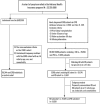Risk, Severity, and Predictors of Obstructive Sleep Apnea in Hemodialysis and Peritoneal Dialysis Patients
- PMID: 30373203
- PMCID: PMC6267173
- DOI: 10.3390/ijerph15112377
Risk, Severity, and Predictors of Obstructive Sleep Apnea in Hemodialysis and Peritoneal Dialysis Patients
Abstract
Our study aimed to determine the incidence and severity of obstructive sleep apnea (OSA) in patients with end-stage renal disease (ESRD) and also whether different dialysis modalities confer different risk and treatment response for OSA. We used Taiwan's National Health Insurance Research Database for analysis and identified 29,561 incident dialysis patients as the study cohort between 2000 and 2011. Each dialysis patient was matched with four non-dialysis control cases by age, sex, and index date. Cox regression hazard models were used to identify the risk of OSA. The incidence rate of OSA was higher in the peritoneal dialysis (PD) cohort than the hemodialysis (HD) and control cohort (18.9, 7.03 vs. 5.5 per 10,000 person-years, respectively). The risk of OSA was significantly higher in the PD (crude subhazard ratio (cSHR) 3.50 [95% CI 2.71⁻4.50], p < 0.001) and HD cohort (cSHR 1.31 [95% CI 1.00⁻1.72], p < 0.05) compared with the control cohort. Independent risk factors for OSA in this population were age, sex, having coronary artery disease (CAD), hyperlipidemia, chronic obstructive pulmonary disease (COPD), and hypertension. Major OSA (MOSA) occurred in 68.6% in PD and 50.0% in HD patients with OSA. In the PD subgroup, the incidence of mortality was significantly higher in OSA patients without continuous positive airway pressure (CPAP) treatment compared with OSA patients undergoing CPAP treatment. The results of this study indicate that ESRD patients were at higher risk for OSA, especially PD patients, compared with control. The severity of OSA was higher in PD patients than HD patients. Treatment of MOSA with CPAP was associated with reduced mortality in PD patients.
Keywords: dialysis; end-stage renal disease; mortality; obstructive sleep apnea.
Conflict of interest statement
The authors declare no conflict of interest.
Figures



Similar articles
-
Risk of sudden sensorineural hearing loss in patients with end-stage renal disease undergoing dialysis.Nephrology (Carlton). 2017 May;22(5):397-402. doi: 10.1111/nep.12800. Nephrology (Carlton). 2017. PMID: 27082416
-
Comparison of Subdural Hematoma Risk between Hemodialysis and Peritoneal Dialysis Patients with ESRD.Clin J Am Soc Nephrol. 2015 Jun 5;10(6):994-1001. doi: 10.2215/CJN.08140814. Epub 2015 Mar 30. Clin J Am Soc Nephrol. 2015. PMID: 25825482 Free PMC article.
-
Permanent cardiac pacing in patients with end-stage renal disease undergoing dialysis.Nephrol Dial Transplant. 2016 Dec;31(12):2115-2122. doi: 10.1093/ndt/gfw302. Epub 2016 Aug 18. Nephrol Dial Transplant. 2016. PMID: 27540047
-
Dialysis Modality and Mortality in the Elderly: A Meta-Analysis.Clin J Am Soc Nephrol. 2015 Jun 5;10(6):983-93. doi: 10.2215/CJN.05160514. Epub 2015 May 4. Clin J Am Soc Nephrol. 2015. PMID: 25941194 Free PMC article. Review.
-
The relationship between obstructive sleep apnea and Parkinson's disease: a systematic review and meta-analysis.Neurol Sci. 2020 May;41(5):1153-1162. doi: 10.1007/s10072-019-04211-9. Epub 2020 Jan 2. Neurol Sci. 2020. PMID: 31897944
Cited by
-
Common Sleep Disorders in Patients With Chronic Kidney Disease: A Systematic Review on What They Are and How We Should Treat Them.Cureus. 2023 Aug 23;15(8):e44009. doi: 10.7759/cureus.44009. eCollection 2023 Aug. Cureus. 2023. PMID: 37746453 Free PMC article. Review.
-
Mechanisms of cognitive dysfunction in CKD.Nat Rev Nephrol. 2020 Aug;16(8):452-469. doi: 10.1038/s41581-020-0266-9. Epub 2020 Mar 31. Nat Rev Nephrol. 2020. PMID: 32235904 Review.
-
Bidirectional Interactions Between Obstructive Sleep Apnea and Chronic Kidney Disease- A Review.Indian J Otolaryngol Head Neck Surg. 2024 Dec;76(6):5066-5070. doi: 10.1007/s12070-024-04976-2. Epub 2024 Aug 10. Indian J Otolaryngol Head Neck Surg. 2024. PMID: 39559061
-
Bidirectional association of sleep disorders with chronic kidney disease: a systematic review and meta-analysis.Clin Kidney J. 2024 Oct 18;17(11):sfae279. doi: 10.1093/ckj/sfae279. eCollection 2024 Nov. Clin Kidney J. 2024. PMID: 39525685 Free PMC article.
-
Intradialytic nutrition and quality of life in Chilean older patients in hemodialysis with protein-energy wasting.Int Urol Nephrol. 2022 Aug;54(8):1947-1955. doi: 10.1007/s11255-021-03077-1. Epub 2021 Dec 3. Int Urol Nephrol. 2022. PMID: 34860339 Free PMC article.
References
-
- Gottlieb D.J., Yenokyan G., Newman A.B., O’connor G.T., Punjabi N.M., Quan S.F., Redline S., Resnick H.E., Tong E.K., Diener-West M., et al. Prospective study of obstructive sleep apnea and incident coronary heart disease and heart failure: The sleep heart health study. Circulation. 2010;122:352–360. doi: 10.1161/CIRCULATIONAHA.109.901801. - DOI - PMC - PubMed
-
- Redline S., Yenokyan G., Gottlieb D.J., Shahar E., O’connor G.T., Resnick H.E., Diener-West M., Sanders M.H., Wolf P.A., Geraghty E.M., et al. Obstructive sleep apnea-hypopnea and incident stroke: The sleep heart health study. Am. J. Respir. Crit. Care Med. 2010;182:269–277. doi: 10.1164/rccm.200911-1746OC. - DOI - PMC - PubMed
-
- Walia H.K., Li H., Rueschman M., Bhatt D.L., Patel S.R., Quan S.F., Gottlieb D.J., Punjabi N.M., Redline S., Mehra R. Association of severe obstructive sleep apnea and elevated blood pressure despite antihypertensive medication use. J. Clin. Sleep Med. 2014;10:835–843. doi: 10.5664/jcsm.3946. - DOI - PMC - PubMed
Publication types
MeSH terms
LinkOut - more resources
Full Text Sources
Medical
Miscellaneous

